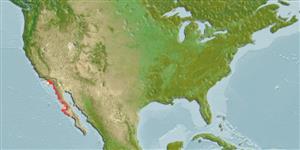>
Eupercaria/misc (Various families in series Eupercaria) >
Sciaenidae (Drums or croakers)
Etymology: Roncador: Spanish, roncar, roncador = snore, snort (1882) (Ref. 45335).
Eponymy: Robert Edwards Carter Stearns (1827–1909) was an American conchologist who served as director of the museum of the California Academy of Sciences. [...] (Ref. 128868), visit book page.
More on author: Steindachner.
Environment: milieu / climate zone / depth range / distribution range
Ecologie
marien demersaal; diepte 1 - 22 m (Ref. 96339). Subtropical; 42°N - 22°N, 125°W - 106°W
Eastern Pacific: Point Conception in California, USA to southern Baja California, Mexico.
Grootte / Gewicht / Leeftijd
Maturity: Lm ? range ? - ? cm
Max length : 70.0 cm TL mannelijk / geslacht onbekend; (Ref. 9118); common length : 30.0 cm TL mannelijk / geslacht onbekend; (Ref. 9118); max. gepubliceerd gewicht: 4.8 kg (Ref. 2850); max. gerapporteerde leeftijd: 15 Jaren (Ref. 56049)
Occur in sandy shores and bays, mostly in shallow surf zones, but also to 15 m depth. Often found near rocks and entrances to bays. Usually form small groups, but aggregate for spawning. Pelagic spawners (Ref. 56049). Feed on invertebrates, such as marine worms, clams, crabs and small crustaceans.
Levenscyclus en paargedrag
Maturiteit | Voortplanting | Paaien | Eieren | Fecunditeit | Larven
Pelagic spawner (Ref. 56049).
Eschmeyer, W.N., E.S. Herald and H. Hammann, 1983. A field guide to Pacific coast fishes of North America. Boston (MA, USA): Houghton Mifflin Company. xii+336 p. (Ref. 2850)
Status op de Rode Lijst van het IUCN (Ref. 130435: Version 2024-2)
Gevaar voor de mens
Harmless
Gebruik door de mens
Visserij: commercieel; sportvis: ja
Tools
Speciale rapporten
Download XML
Internetbronnen
Estimates based on models
Preferred temperature (Ref.
123201): 15.9 - 19.5, mean 17.8 °C (based on 20 cells).
Fylogenetische diversiteitsindex (Ref.
82804): PD
50 = 1.0000 [Uniqueness, from 0.5 = low to 2.0 = high].
Bayesian length-weight: a=0.00851 (0.00415 - 0.01744), b=3.08 (2.91 - 3.25), in cm total length, based on LWR estimates for this (Sub)family-body shape (Ref.
93245).
Trofisch niveau (Ref.
69278): 3.3 ±0.44 se; based on food items.
Generation time: 3.8 ( na - na) years. Estimated as median ln(3)/K based on 1
growth studies.
Weerstandsvermogen (Ref.
120179): Gemiddeld, minimale populatieverdubbelingstijd 1,4-4,4 jaar (tm=2.5; tmax=15).
Fishing Vulnerability (Ref.
59153): Moderate vulnerability (39 of 100).
Nutrients (Ref.
124155): Calcium = 69.6 [38.7, 139.0] mg/100g; Iron = 0.979 [0.496, 1.744] mg/100g; Protein = 19.6 [18.5, 20.7] %; Omega3 = 0.261 [0.142, 0.434] g/100g; Selenium = 23.6 [12.6, 48.5] μg/100g; VitaminA = 9.3 [3.0, 31.4] μg/100g; Zinc = 0.726 [0.527, 1.061] mg/100g (wet weight);
